

Design Activism. Blog. Climate Reality. Trust Design - Trust Design - A Premsela Designworld Project. We Are What We Do. Tools of Change - Getting Informed. In this section you will be mapping out potential partners for your program.
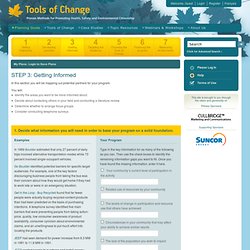
You will: Identify the areas you want to be more informed about. Decide about contacting others in your field and conducting a literature review. Determine whether to arrange focus groups. Consider conducting telephone surveys. In 1989 Boulder estimated that only 27 percent of daily trips involved alternative transportation modes while 73 percent involved single-occupant vehicles. Go Boulder identified potential barriers for specific target audiences. Get in the Loop - Buy Recycled found that far fewer people were actually buying recycled-content products than had been predicted on the basis of purchasing intentions.
JEEP had seen demand for power increase from 6.3 MW in 1981 to 11.9 MW in 1991. JEEP wanted people to purchase and install energy saving devices. Quinte's participation in residential composting was 34 percent in 1992. Tip: You may need to cut corners if you are limited by time or other resources. Public/world.lasso. The 1 Liter Limit Water-Saver Faucet Strictly Rations then Refills. Email This innovative faucet called 1LL has been designed by Yonggu Do, Dohyung Kim & Sewon Oh, and is an eco-friendly faucet that stores up a precise amount of water between uses, and then pours it out on demand.
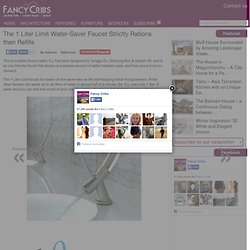
The 1 Liter Limit faucet it’s based on the same idea as the self-stopping hand-drying blowers. While other faucets can waste up to six liters of water in almost half of a minute, the 1LL uses only 1 liter of water and you can see how much of your one-liter water allocation is left, in the tube above the tap. Miscea Sensor Activated Faucet: Sexy, Eco-Friendly, And Leaves You Squeaky Clean. Anti Waste Faucet (5) - Gadget Reviews. Modern faucets - Home Decorating Ideas and Interior Design Inspiration. Design & Behaviour. What Your Home Will Look Like In 2015. Here at FastCompany we often write about futurist predictions of life in 20, 30, even 100 years down the line.
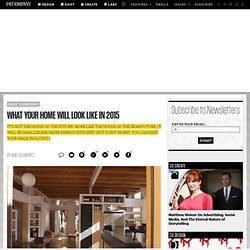
But the National Association of Home Builders is offering up a vision of how we'll live in just four years--and it's a little different than what you might expect. The NAHB sent out a survey last year that asked members--designers, architects, manufacturers, and more-- what they think homes will look like in 2015. Some of the results aren't that surprising. The survey reveals that the average single-family home is likely to drop to 2,150 square feet from 2,400 square feet today, probably as a result of tough economic times and rising energy prices. That drop in square footage will lead to the living room disappearing altogether, instead being swallowed up by the kitchen or family room to form a single "great room. " A more important future trend is the use of resource-efficient features.
Changing Behavior by Design: Forbes Interview with Jon Kolko. By Sam Martin - June 16, 2010 A well-crafted product can make the world a better place.
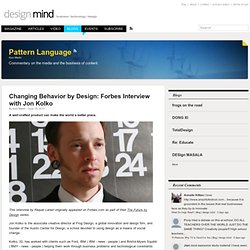
This interview by Raquel Laneri originally appeared on Forbes.com as part of their The Future by Design series. Jon Kolko is the associate creative director at Frog Design, a global innovation and design firm, and founder of the Austin Center for Design, a school devoted to using design as a means of social change.
Kolko, 32, has worked with clients such as Ford, IBM ( IBM - news - people ) and Bristol-Myers Squibb ( BMY - news - people ) helping them work through business problems and technological constraints through design. "In specific, I solve problems for large companies," says Kolko, "in general, I slowly shift behavior in culture and society. " Previously Kolko taught at Savannah College of Art and Design. Shaping Our Places » The Fun Theory: Changing behaviour through design.
VISI / Blogs. The outcome of UK magazine Blueprint's challenge struck a chord for Alma.
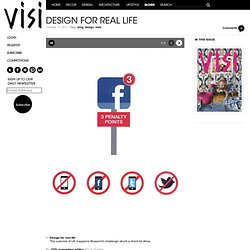
By VISI managing editor Alma Viviers Four separate incidents cause Alma Viviers to re-examine the nature of design and the roles of designers. Incident #1 During 100% Design, UK magazine Blueprint challenged a series of designers, artists and architects to rethink the ubiquitous road sign. The results of this creative challenge produced, at least for me, a powerful reflection on how sluggish institutional elements like signage are in catching up to modern life.
The signs that display the Facebook, Twitter and Apple loading icons in particular struck a cord with me as none of these are actions that you can perform on a hands-free set (except if you have the Apple iPhone with Siri voice assistant). Incident #2 The gala dinner for the culmination of the visit of the 2014 World Design Capital judges was an evening filled with plenty of celebration and deserved back-patting. Incident #3 Incident #4 Source: 0 Comments. Design philosophy papers > 2003.